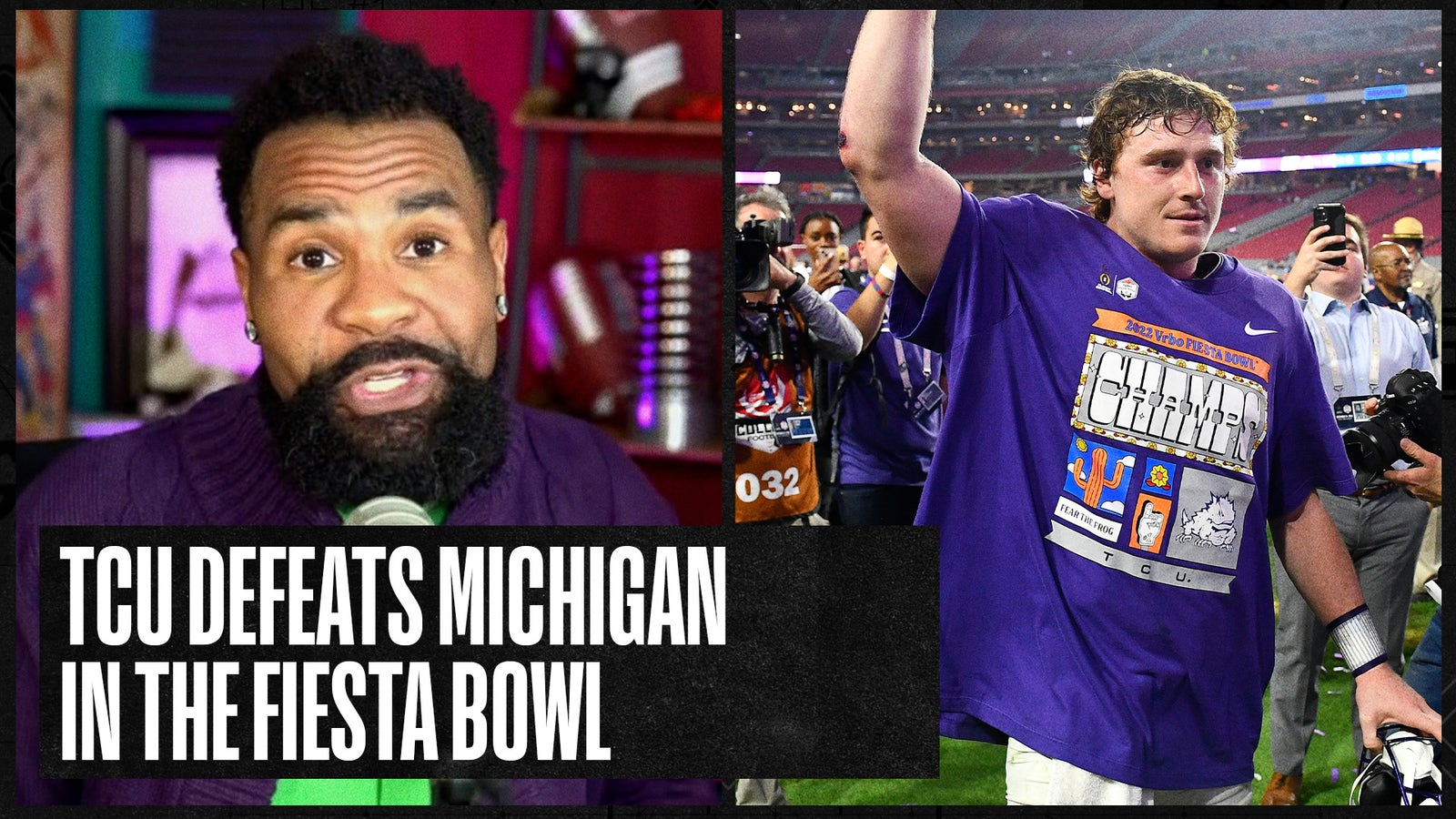How should Buckeye fans feel about Ohio State?

[ad_1]
Michael Cohen
College Football and College Basketball Writer
In late November, a few weeks before the coaching carousel rerouted him to Louisville, then-Purdue head coach Jeff Brohm appeared on a Zoom call to preview the program’s inaugural trip to the Big Ten Championship.
The Boilermakers had won the league’s topsy-turvy West division, a group best known for dropping nine consecutive title games to whichever challengers emerged from the East. Oddsmakers expected more of the same in 2022 by making undefeated Michigan a 15-point favorite. And the more Brohm studied the Wolverines on film, the more he saw a team capable of finishing the season unbeaten — College Football Playoff games included.
“To me,” Brohm said, “that’s what the Big Ten is known for: great defenses and tremendous running games. And if you can add the passing game, then you’ve really got a chance. In this conference, you’re going to have at least a month of bad-weather games, and you’ve got to be able to do things other than just spread the ball out and throw it.
“So I think your best teams statistically are doing exactly what Michigan does. They can pound the football. They can run it at you. They have a lot of different sets. They can spread you out when they need to. They play outstanding defense. And, now, they have the element of a really athletic, talented quarterback that allows them to throw the ball vertically. A lot of big plays in this pass game, throwing the ball over their heads and taking advantage of that. So I think you just piece all that together, and you got a recipe for a national championship team.”

It was hard to argue with Michigan’s credentials on paper. The Wolverines entered the CFP ranked third nationally in rushing offense and had a defense that ranked among the top five in scoring, rushing, pass efficiency and first downs allowed. So when sophomore quarterback J.J. McCarthy sliced open Ohio State for 263 yards and three touchdowns, finally complementing the ground game with bona fide aerial prowess, it certainly felt like Jim Harbaugh’s team had the total package.
But for the second consecutive year, Michigan’s greatest strengths were neutralized on the sport’s biggest stage in a 51-45 loss to Texas Christian that exposed some of the same weaknesses unearthed in the Orange Bowl last year. And when Ohio State fared no better in a 42-41 loss to Georgia later that evening, questions about the veracity of a Big Ten team winning the national title for the first time since the Buckeyes did it in 2014 bubbled to the surface on a night two southern schools rejoiced.
“When you put that much work and that much energy and that much time into something, and you’re right there and you just don’t get the victory,” said Ohio State head coach Ryan Day, his voice trailing off in disappointment. “This is a performance business, and you win or you lose — and we lost the game. That’s just what hurts to our core. We’re here to win, and it didn’t happen.”
There are two lenses through which the 2022 campaign can be viewed for fans of Midwestern football. Donning a set of rose-tinted glasses means appreciating the Big Ten as just the second league to have two teams reach the national semifinals in the same year, a feat first accomplished by the Southeastern Conference. Its two entrants — Michigan and Ohio State — lost the Fiesta Bowl and Peach Bowl, respectively, by seven combined points, with both programs having a chance to win in the waning seconds. And after two decades of regression, Harbaugh’s reclamation of his alma mater’s place in the college football pantheon is a boon for the sport.
“Fought our hearts out,” McCarthy said in the postgame news conference before walking out after responding to a single question. “There’s a lot of things that we could have done better. Can’t wait to watch the tape. But we’ll be back, and I promise that.”
Another unremarkable non-conference schedule in 2023, coupled with the returns of star players like McCarthy, tailback Donovan Edwards and inside linebacker Junior Colson, means the Wolverines have a strong chance of clinching their third consecutive CFP berth next season. But in order to avoid another defeat, Harbaugh’s team will need to narrow some gaps — speed, strength, toughness and game planning — that were exposed by Georgia and TCU, as Michigan learned the difference between simply reaching the semifinals and getting over the hump.

There should be genuine concern for Harbaugh and co-offensive coordinators Sherrone Moore and Matt Weiss that an offensive line crowned the best in college football for back-to-back seasons was outclassed both times it faced a highly-ranked opponent from beyond the Big Ten. Last season’s Wolverines surrendered 30 quarterback pressures, four sacks and seven tackles for loss to a historically talented Georgia defense loaded with NFL draft picks. This year’s Wolverines were thrashed for 20 quarterback pressures, four sacks and 13 tackles for loss by an undersized TCU front that features only one surefire pro.
That Michigan entered the Fiesta Bowl allowing just 4.3 tackles for loss per game speaks to how poorly the offensive line performed, and the Horned Frogs wound up with a 263-186 edge in rushing yards.
Left guard Trevor Keegan, who said the Wolverines got overwhelmed, finished with his worst run-blocking grade of the year on Pro Football Focus. Left tackle Ryan Hayes and center Olu Oluwatimi, who won both the Rimington Award and the Outland Trophy, each posted their 10th-best marks of the campaign. None of Michigan’s starting linemen produced scores that exceeded their individual season averages when their tailbacks needed them most.
“We talked about all week leading up to the game how important it would be to play physical,” said TCU head coach Sonny Dykes in his postgame news conference. “And I thought we were definitely the most physical team on the field tonight.”
Equally concerning were the defensive breakdowns endured by both Big Ten programs that underscored their substandard talent and speed across the second and third levels.
The Wolverines, whose first-year defensive coordinator, Jesse Minter, was a finalist for the Broyles Award, came undone with 11 missed tackles that were one shy of their season-high from a win over Illinois, according to PFF. Minter’s aggressive, blitz-heavy approach left his defensive backs vulnerable on the back end, and cornerback DJ Turner whiffed trying to bring down wideouts Taye Barber and Quentin Johnston on a pair of touchdown passes totaling 81 yards. In the running game, where the Horned Frogs averaged 6.4 yards per carry, the tandem of Kendre Miller and Emari Demercado combined to force eight missed tackles.
Across the country, Georgia generated similarly explosive gains against Ohio State to extend the desultory finish to an otherwise exemplary first season for defensive coordinator Jim Knowles, like Minter a semifinalist for the Broyles Award. Day had plucked Knowles from Oklahoma State and made him one of the highest-paid coordinators in the country, with a directive to construct a defense capable of beating Michigan and offering postseason ballast to a perpetually explosive offense. But a handful of lengthy touchdowns doomed Ohio State in its loss to the Wolverines earlier this season — a game in which the secondary proved beatable after Knowles stacked the box — and the Bulldogs capitalized on that same weakness.
Seven different Georgia players caught passes gaining at least 20 yards on Saturday, capped by a 76-yard touchdown to wideout Arian Smith that twisted safety Lathan Ransom in coverage. Quarterback Stetson Bennett completed 23 of 34 passes for 398 yards and three scores to outgain his counterpart, C.J. Stroud, and keep the Bulldogs’ dream of back-to-back titles alive. Stroud played arguably the best game of his career, with 348 yards and four touchdowns, but will leave Ohio State without playing in a championship game of any kind.
“We did give up some explosive plays again,” Day said. “And it was something that we spent a lot of time talking about is avoiding the big play. I think the difference was, in this game, it didn’t demoralize us. We kept swinging and fighting, and we just kept going at it.
“But call it for what it is: If we’re going to win these games, we can’t give up those big, explosive plays. They’re hard to come back from.”
Understanding the recipe for winning a national title is one thing. Amassing the right coaches and players to achieve it is another.
Read more:
Top stories from FOX Sports:
Michael Cohen covers college football and basketball for FOX Sports with an emphasis on the Big Ten. Follow him on Twitter @Michael_Cohen13.

Get more from College Football Follow your favorites to get information about games, news and more
[ad_2]
Source link
This website uses cookies so that we can provide you with the best user experience possible. Cookie information is stored in your browser and performs functions such as recognising you when you return to our website and helping our team to understand which sections of the website you find most interesting and useful.
Strictly Necessary Cookie should be enabled at all times so that we can save your preferences for cookie settings.
If you disable this cookie, we will not be able to save your preferences. This means that every time you visit this website you will need to enable or disable cookies again.